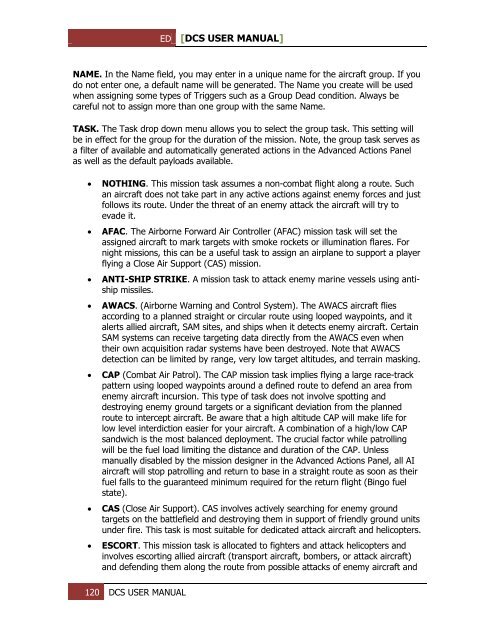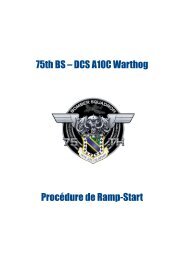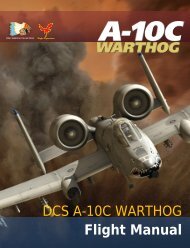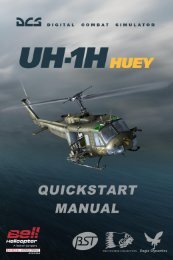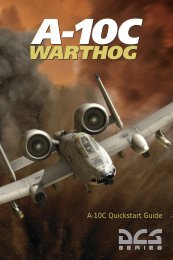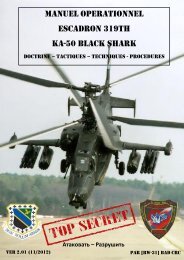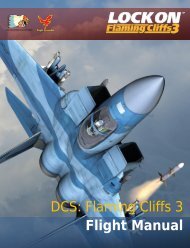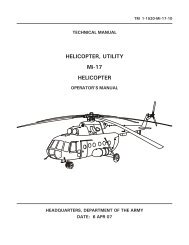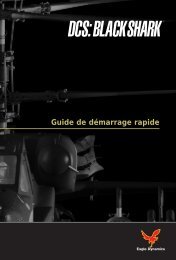You also want an ePaper? Increase the reach of your titles
YUMPU automatically turns print PDFs into web optimized ePapers that Google loves.
ED [<strong>DCS</strong> USER MANUAL]<br />
NAME. In the Name field, you may enter in a unique name for the aircraft group. If you<br />
do not enter one, a default name will be generated. The Name you create will be used<br />
when assigning some types of Triggers such as a Group Dead condition. Always be<br />
careful not to assign more than one group with the same Name.<br />
TASK. The Task drop down menu allows you to select the group task. This setting will<br />
be in effect for the group for the duration of the mission. Note, the group task serves as<br />
a filter of available and automatically generated actions in the Advanced Actions Panel<br />
as well as the default payloads available.<br />
<br />
<br />
<br />
<br />
<br />
<br />
<br />
NOTHING. This mission task assumes a non-combat flight along a route. Such<br />
an aircraft does not take part in any active actions against enemy forces and just<br />
follows its route. Under the threat of an enemy attack the aircraft will try to<br />
evade it.<br />
AFAC. The Airborne Forward Air Controller (AFAC) mission task will set the<br />
assigned aircraft to mark targets with smoke rockets or illumination flares. For<br />
night missions, this can be a useful task to assign an airplane to support a player<br />
flying a Close Air Support (CAS) mission.<br />
ANTI-SHIP STRIKE. A mission task to attack enemy marine vessels using antiship<br />
missiles.<br />
AWACS. (Airborne Warning and Control System). The AWACS aircraft flies<br />
according to a planned straight or circular route using looped waypoints, and it<br />
alerts allied aircraft, SAM sites, and ships when it detects enemy aircraft. Certain<br />
SAM systems can receive targeting data directly from the AWACS even when<br />
their own acquisition radar systems have been destroyed. Note that AWACS<br />
detection can be limited by range, very low target altitudes, and terrain masking.<br />
CAP (Combat Air Patrol). The CAP mission task implies flying a large race-track<br />
pattern using looped waypoints around a defined route to defend an area from<br />
enemy aircraft incursion. This type of task does not involve spotting and<br />
destroying enemy ground targets or a significant deviation from the planned<br />
route to intercept aircraft. Be aware that a high altitude CAP will make life for<br />
low level interdiction easier for your aircraft. A combination of a high/low CAP<br />
sandwich is the most balanced deployment. The crucial factor while patrolling<br />
will be the fuel load limiting the distance and duration of the CAP. Unless<br />
manually disabled by the mission designer in the Advanced Actions Panel, all AI<br />
aircraft will stop patrolling and return to base in a straight route as soon as their<br />
fuel falls to the guaranteed minimum required for the return flight (Bingo fuel<br />
state).<br />
CAS (Close Air Support). CAS involves actively searching for enemy ground<br />
targets on the battlefield and destroying them in support of friendly ground units<br />
under fire. This task is most suitable for dedicated attack aircraft and helicopters.<br />
ESCORT. This mission task is allocated to fighters and attack helicopters and<br />
involves escorting allied aircraft (transport aircraft, bombers, or attack aircraft)<br />
and defending them along the route from possible attacks of enemy aircraft and<br />
120 <strong>DCS</strong> USER MANUAL


